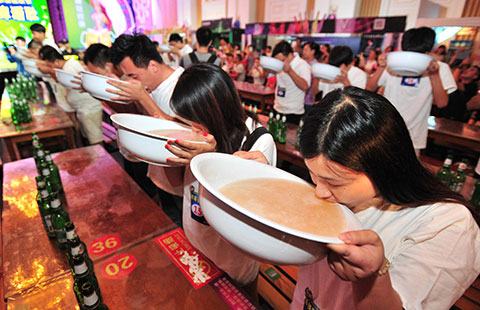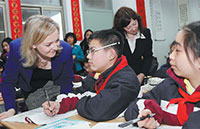China will invest 5 trillion yuan in national fitness
By Xinhua (China Daily) Updated: 2014-12-26 07:38Yu Liang, the CEO of China's residential real estate developer Vanke, used to be a busy entrepreneur who seldom exercised. In order to pursue his dream of conquering Mount Qomolangma, also known as Mount Everest, he started running four years ago.
Three years later, the 49-year-old Yu fulfilled his dream and has become an enthusiastic promoter of running. In 2013, he launched a series of road race events called Run for Fun. This year, events have spread to 60 cities in China and attracted more than 100,000 participants.
"When I asked my friends to climb Mount Qomolangma with me, no one volunteered. But when I asked them to join me in running, nearly everyone said yes," a smiling Yu said.
Yu has lost nearly 15 kilograms since he started to run regularly. Running has become part of his life. He even takes his running shoes along on business trips.
While entrepreneurs like Yu are organizing sports events for the public, the government's sports departments are busy developing apps for smartphones.
The Sports Bureau of Hubei province developed a smartphone application in 2014 called "Go Exercise", which steers users toward participation in physical fitness activities. With the app, residents of Wuhan can find the nearest venue for exercise at a reasonable price, or even free. All they need to do is download the app, which is also free.
During the two-month test of Go Exercise, about half a million citizens in Wuhan used the application.
The popularity of grassroots running events and the rise of sports-oriented apps reflect an ever-growing demand for fitness. Since the launch of National Fitness Day in 2009, the notion of investment in health has taken firmer root among Chinese, and physical fitness is getting more attention.
The State Council unveiled a policy document in October announcing plans to develop the country's sports industry and raising the sector's annual output to 5 trillion yuan ($804 billion) by 2025.
The document also stressed that promoting public fitness will become one of the government's national strategies and laid out a goal of 2 square meters of sports ground per capita by 2025, with the number of people exercising regularly reaching 500 million.
"It is the most important news for China's national fitness work," said Liu Guoyong, head of the Sport for All department of China's State General Administration of Sports.
Results of a survey released by the Chinese Academy of Sciences in August showed that 50.5 percent of Chinese people between 20 and 69 years of age exercised at least once in 2013, a 1.3 percent increase compared with 2012. Even though not all of them exercised enough, the annual average individual expenditure on exercise and sports-related goods reached 645 yuan.
"These numbers made us believe that we can achieve the 5-trillion-yuan target by 2025," Liu said, although he also acknowledged that the distribution of sports facilities is not balanced across all regions, and especially between urban and rural areas," Liu said.
- Govt encourages people to work 4.5 days a week
- Action to be taken as HIV cases among students rise
- Debate grows over reproductive rights
- Country's first bishop ordained in 3 years
- China builds Tibetan Buddhism academy in Chengdu
- Authorities require reporting of HIV infections at schools
- Typhoon Soudelor kills 14 in East China
- Police crack down on overseas gambling site
- Debate over death penalty for child traffickers goes on
- Beijing to tighten mail security for war anniversary







